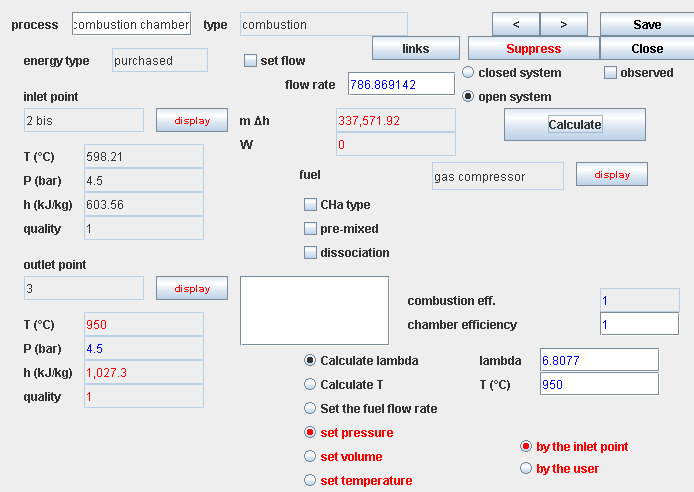Combustions
This session discusses the thermodynamics of combustion.
In combustion chambers operating in an open system, it is generally assumed that the outlet pressure equals the inlet pressure. If you want to refine the analysis, you can consider that there is a small pressure drop, but it may be neglected in first approximation.
It follows that the reference process is the isobar.
Boilers and combustion chambers in which combustion takes place baing fixed, the useful work put in is zero.
Moreover, at the entrance and exit of these components, the velocities of fluids are always relatively low, so that the kinetic energies are negligible.
Under these conditions the first principle writes simply for combustion chambers: Δh = Q
Calculate the heat brought into play in these components is to determine the enthalpy change of the fluid flowing through them.
Course reference:
- “Technological Components / Combustion”
To follow the presentation, go to next step
(Session realized on 06/16/11 by Renaud Gicquel)COMBUSTION THERMODYNAMICS
| Component | molar fraction % |
molar mass kg/kmole |
mass fraction % |
|---|---|---|---|
| N2 | 0.781 | 28 | 0.756 |
| Ar + CO2 | 0.009 | 40 | 0.012 |
| O2 | 0.210 | 32 | 0.232 |
| N2 atmosph. | 0.790 | 28.15 | 0.768 |
COMBUSTION THERMODYNAMICS
- Stoechiometry
- highest combustion temperature
COMBUSTION THERMODYNAMICS
- Non stoichiometric
- excess air: e
- richness: R = 1 / λ
- air factor: λ = 1 + e
λ > 1
COMBUSTION THERMODYNAMICS
- Incomplete combustion
COMBUSTION THERMODYNAMICS
- CO2 dissociation
CO2 + H2 ↔ CO + H2O
COMBUSTION THERMODYNAMICS
- CO2 dissociation
- quenching temperature:
- temperature to be used in the law of mass action to get the actual exhaust gas composition
Combustion calculation steps
- analyze the compositions of the fuel and oxidizer
- Set λ, Tquench and the CO2dissociation rate
- determine the composition of products
- calculate the heat of reaction involved
- calculate the end of combustion temperature
COMBUSTION THERMODYNAMICS
- Higher and Lower Heating Values
- Higher Heating Value (HHV) water contained in the fume is liquefied
- Lower Heating Value (LHV) water produced remains in the vapor state
COMBUSTION THERMODYNAMICS
- Heat of reaction
- ν1 A1 + ν2 A2 ↔ ν3 A3 + ν4 A4
-
(4.6.30)
-
hf enthalpies of formation (1 bar, 25 °C)
- (0 for pure substances)
-
- ΔHr function of the νi and thus of the xi
Variation of the heat of reaction in case of lack of air
Let us calculate for example the heat of reaction of octane for a stoichiometric reaction:
C8H18 + 12.5 O2 + 3.76 x 12.5 N2 →8 CO2 + 9 H2O + 3.76 x 12.5 N2
- ΔHr = hfC8H18 + 12.5 hfO2 - 8 hfCO2 - 9 hfH2O
- ΔHr = - 208450 + 0 - 8 (-393520) - 9 (-285830) = 5 512 180 kJ/kmole
The molar mass of octane being 114.22 kg / kmol, its heat of reaction mass is equal to:
- Qp = 48 259 kJ/kg
If the reaction is not stoichiometric, but occurs in the absence of air, the formation of carbon monoxide decreases the heat of reaction.
For richness equal to 1.25, for example, the reaction becomes:
C8H18 + 10 O2 + 37.6 N2 → 3 CO2 + 5 CO + 9 H2O + 37.6 N2
- ΔHr = hfC8H18 + 10 hfO2 - 3 hfCO2- 5 hfCO - 9 hfH2O
- ΔHr = - 208450 + 0 - 3 (-393520) - 5 (- 110530)- 9 (-285830) = 4 097 230 kJ/kmole
i.e. a decrease of 25.7% over the stoichiometric reaction.
COMBUSTION THERMODYNAMICS
- End of combustion temperature
- adiabatic flame temperature
-
Basic equation:
- the heat released by the combustion is used to heat the reaction products
- maximal at stoichiometry
- function of the air factor λ
- quite complex calculation
COMBUSTION THERMODYNAMICS
- Adiabatic flame temperature
COMBUSTION THERMODYNAMICS
- Calculation of combustion in Thermoptim
- either in the form CHa (enter the values of a and hf0 relative to the formulation Cha)
- or as a compound gas (chemical formulas are decoded)

COMBUSTION THERMODYNAMICS 

Combustions
This session discusses the thermodynamics of combustion.
We have shown that:
Combustion process setting
Setting this process being a bit more complex than others, we suggest you refer to the Thermoptim documentation for further explanations.
The downloadable document below shows the information provided orally with the previous screen.